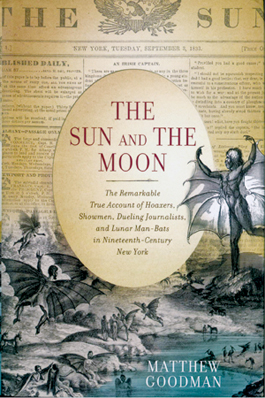home | metro silicon valley index | the arts | books | review

The Sun and the Moon
Reviewed by Michael S. Gant
IN THE SUMMER of 1835, a story so fantastical, so unbelievable appeared in the pages of the New York Sun that people naturally had no choice but to believe it. Purporting to provide the first breathless reports in the United States, author Richard Adams Locke disclosed the existence of life on the moon. The momentous discovery was the work of the famed astronomer Sir John Herschel at his observatory on the Cape of Good Hope. Not just life mind you, but a downright cornucopia of fauna, including "beavers that walked on their hind legs and unicorns," not to mention intelligent man-bats, or Vespertilio-homo. Shades of the Weekly World News' famed Bat-boy indeed.
This amazing 11,000-word story, the first in a sensational series, set off a fury of speculation among New Yorkers from all walks of life, for the Sun was one of the new penny papers that were beginning to reach a large and diverse readership. Debate was heated, and the other papers scoffed, but apparently most of the city believed, at least for a while, in what eventually became known as the Moon Hoax. In The Sun and the Moon, Matthew Goodman relates the affair in all its juicy details, with some excellent asides about the growth of the modern popular newspaper along the way.
Goodman's large cast of characters includes Locke, an erudite English expat whose learned prose helped put over the fakery; Benjamin Day, the farseeing founder of the Sun; James Gordon Bennett, the editor of the competing Morning Herald, a pugnacious man of letters who enjoyed a good duel; and Edgar Allan Poe, who published a short story about a balloon trip to the moon earlier that summer and believed that he his idea had been stolen. The hoax helped launch the Sun as "a new kind of newspaper" that purveyed "crime, scandal, sports, entertainment" to a mass audience. Goodman writes that Day wanted his readers "to be entertained as well as edified. Even more, they wanted to find out about the life that was going on around them." That inclusive idea proved to be a sturdy publishing model, at least until the arrival of the Internet. As for hoaxes, the Moon Hoax was the biggest ever—until WMD in Iraq, at least. (By Matthew Goodman; Basic Books; 350 pages; $26 hardback)
Send a letter to the editor about this story.
|
|
|
|
|
|
